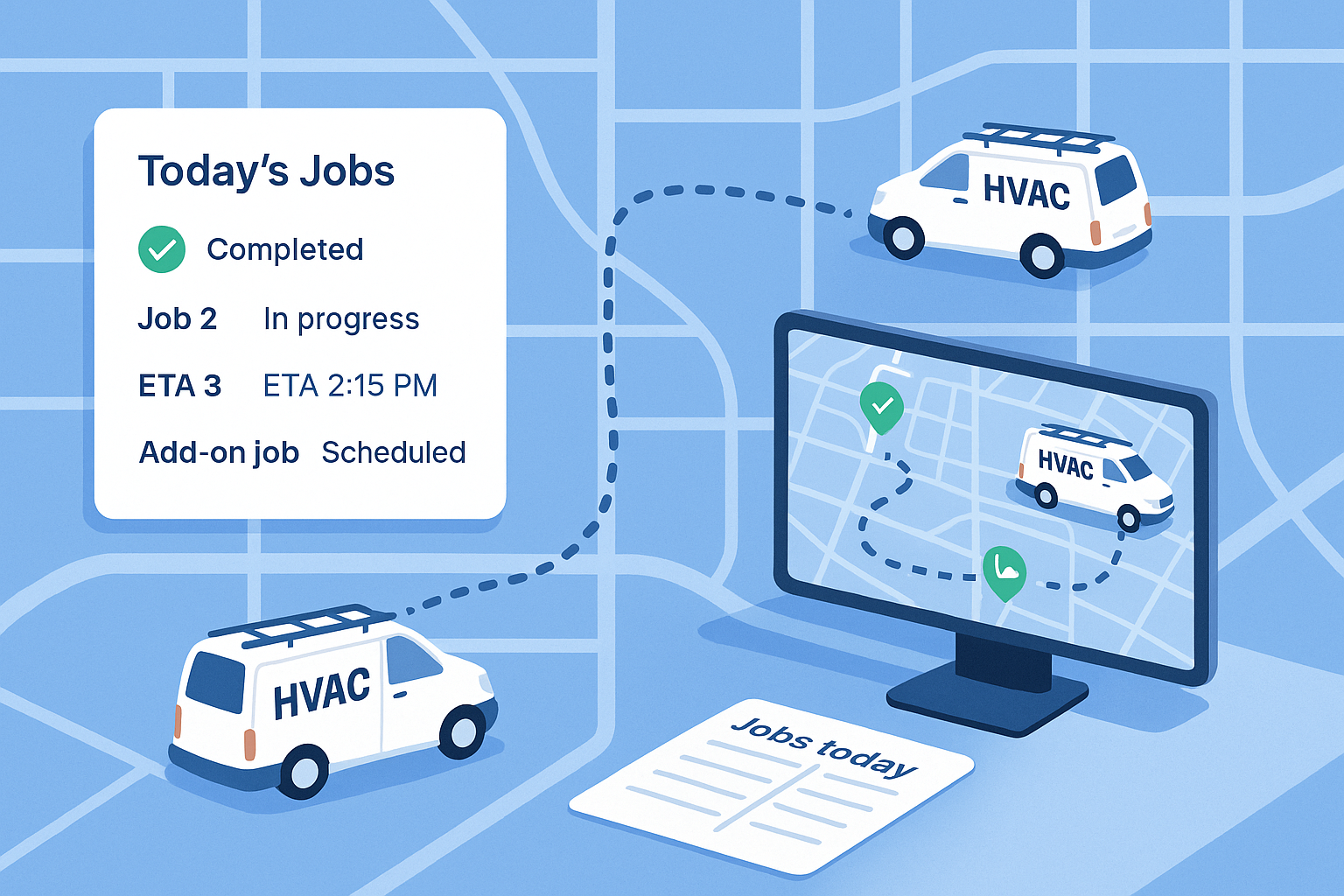How HVAC Companies Use GPS Fleet Tracking to Fit in More Jobs Per Day (Without Adding Vans)
If you run an HVAC company, you probably feel the same pressure every season:
- Too many calls, not enough trucks
- Techs stuck in traffic or crisscrossing the city
- Days where you end up turning down work you could have done
You don’t always need more vans or techs to grow. In many cases, you just need to tighten how you use the fleet you already have.
That’s where HVAC GPS fleet tracking comes in. With the right setup, you can see every truck on one screen, shorten the gaps between jobs, and fit more calls into the same 8–10 hour day.
If you missed it, our first HVAC piece covers 5 ways you’re losing money without GPS tracking (and how to fix each one). This article focuses on a different question:
How do you use HVAC GPS fleet tracking to actually run more jobs per day without burning out your technicians?
1. See the whole day on one screen instead of 20 text threads
The old way
Most small HVAC shops still run dispatch the hard way:
- Calls and texts to each tech – "Where are you now?"
- Printed job tickets that get scribbled on and lost
- Guessing who’s closest to the next call
By noon, your dispatcher’s brain is fried and your schedule is already off.
The GPS-driven way
With a proper HVAC fleet tracking system, your dispatcher sees:
- A live map of every van, updating in seconds
- Which jobs are done, in progress, or running late
- Which techs are closest to upcoming calls
Instead of guessing, you can:
- Slot in add-on jobs into real gaps (not imagined ones)
- Move calls away from overloaded techs
- React quickly when a job runs long or a tech calls out
That visibility alone often creates space for one or two extra jobs per truck per week—without adding a single vehicle.
2. Dispatch the right tech, not just the next name on the list
The problem
When your dispatcher can’t see where anyone actually is, it’s tempting to run the board in a straight line:
- Tech A gets these three jobs
- Tech B gets those three jobs
- Hope the geography works out
You end up with:
- Techs driving back and forth across town
- Skilled techs doing simple work while less experienced techs struggle with tough calls
- Unnecessary overtime because of bad pairings
How HVAC GPS fleet tracking fixes it
With GPS and basic tagging in your system, you can dispatch based on:
- Location – who is actually closest right now
- Skill or specialty – who handles minisplits, boilers, or rooftop units faster
- Zones – who usually runs a given territory and knows the area
Instead of pushing every job down the list, you can match calls to the right tech + closest truck. That combination is what lets you:
- Finish complicated jobs faster
- Leave slack in the day for urgent calls
- Protect your best techs from being overloaded while others coast
3. Shorten the “dead time” between jobs
The problem
Most fleets lose a surprising amount of time in the gaps between jobs:
- Techs sitting in driveways finishing paperwork
- Slow departures after a job is finished
- Detours for food, personal errands, or “quick stops”
On paper, a tech might have six jobs scheduled. In reality, they only finish four or five because the gaps eat the day.
What GPS data gives you
With trip and stop history from your HVAC GPS fleet tracking system, you see:
- Exact arrival and departure times at each job
- How long techs spend parked at non-job locations
- Which routes they actually took between calls
That lets you:
- Coach techs who consistently take too long to leave a completed job
- Spot patterns of unnecessary long stops and address them directly
- Plan routes that flow better from neighborhood to neighborhood
Even cutting 10–15 minutes of dead time between jobs adds up fast over a full day and full fleet.
4. Tighten your service windows without blowing up your schedule
The problem
Customers hate vague windows:
- “We’ll be there sometime between 8 and 12”
- “We’ll try for afternoon”
But when you don’t know how long jobs really take, tightening windows feels risky. One long job can knock out the rest of the day.
How GPS data helps
With a month or two of trip history, you can see:
- Average time on site for different job types (maintenance vs install vs diagnostic)
- How long it really takes to drive between common zones at different times of day
- Which techs consistently run long vs on time
Now you can:
- Set realistic standard durations per job type
- Build tighter windows (e.g., 2-hour instead of 4-hour) based on actual data
- Assign “tight window” jobs to your most punctual techs
Tighter windows + better on-time performance = fewer cancellations and more room for extra calls.
5. Rebuild your daily schedule using real numbers, not gut feel
The problem
If your schedule is built on guesswork, you almost always under-use part of the day and overload another.
Common patterns:
- Mornings start slowly while techs “warm up”
- Midday gets slammed and you fall behind
- End of day turns into overtime to finish commitments
What to do with GPS history
Once your HVAC fleet tracking system has a few weeks of data, sit down (or have your dispatcher sit down) and look at:
- How many jobs each tech actually completes on most days
- Which job mixes work best together (e.g., 3 maintenance + 1 install)
- Where in the day you consistently fall behind
Then, adjust your template:
- Give techs realistic maximums instead of aspirational ones
- Reserve 1–2 “flex” slots per van per day for emergencies or add-ons
- Cluster jobs by geography, not just time
The goal isn’t to squeeze every second out of the day. It’s to build a schedule that you can hit 80–90% of the time, while still leaving room for profitable last-minute work.
6. The HVAC GPS fleet tracking features that matter for scheduling
There are a lot of fleet systems out there. If your priority is “more jobs per day,” focus on these features first:
- Fast location updates – so dispatch can see when a tech is wrapping up and slot in the next job
- Trip and stop history – to analyze how long jobs really take and where dead time hides
- Geofences – for arrival/departure alerts at your yard and key customers
- Driver behavior tracking – not just for safety, but to control fuel and avoid aggressive driving that leads to downtime
- Easy user access – so owners, dispatchers, and leads can all see the same live map
Our own HVAC fleet tracking software was built with exactly this in mind: 1-second updates when you need them, detailed trip history, off-hours alerts, and plug-in OBD or wired trackers that you can install yourself.
7. How to roll this out in a 10-truck HVAC fleet
You don’t need to turn your entire operation upside down on day one. Here’s a simple way to start:
Step 1: Pick 5–10 vehicles for your pilot
- Choose a mix of techs: dependable, average, and a couple who struggle with time
- Include at least one van from each major zone or crew
Step 2: Talk to your techs before you install anything
- Explain the goals: fewer “where are you?” calls, better routing, less chaos—not spying
- Be clear about what’s tracked (vehicle movement) and what’s not
- Share that the data will be used to fix scheduling, not just punish people
Step 3: Install trackers and let data build up
- Plug OBD devices into the port or wire in permanent trackers
- Make sure each vehicle is properly labeled in the app
- Run for at least 2–4 weeks before making big changes
Step 4: Do a simple review
Once you have a few weeks of data, look at:
- Average jobs completed per day per truck
- Where you consistently run ahead or behind schedule
- How much time is spent at jobs vs in between
Use that to adjust:
- Route planning and territory assignments
- Job mix per van (easier vs harder calls)
- Service windows you promise customers
Step 5: Roll out to the rest of the fleet
- Share early wins with the team (fewer calls, fewer late nights, better routes)
- Install trackers on remaining vehicles
- Make GPS data part of regular dispatch and performance reviews—not just a one-time project
What to do next
If you’re already convinced HVAC GPS fleet tracking can help, the next step is straightforward:
- Decide which vehicles to start with – usually 5–10 vans is plenty.
- Install plug-in OBD or wired trackers – no shop visit required.
- Use the first month as a “data month” – don’t change everything, just watch.
- Adjust your schedule and routes based on what you see.
When you’re ready to try it yourself, you can get started in minutes.
Explore HVAC GPS fleet tracking, choose your trackers, and see how many extra jobs you can fit into your day without adding a single van.


Share:
HVAC GPS Fleet Tracking: 5 Ways You’re Losing Money Without It (And How to Fix Each One)
GPS Fleet Tracking for Landscaping Companies: Stop Route Drift, Side Jobs, and Fuel Waste